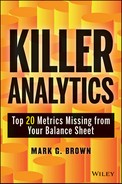Foreword
Insights and knowledge lead to better decisions and it is those better decisions that lead to improved business performance. Companies that outperform their peers are those that underpin their decisions by facts, data, and analytics. I call those companies intelligent companies and believe Killer Analytics: Top 20 Metrics Missing from Your Balance Sheet by Mark Graham Brown will help any business become more intelligent. More intelligent analytics are no longer a nicety to have but a required core competence that enables any company to compete in today’s data-driven world. Enterprises without the right analytics will simply be outsmarted by their competitors and left behind.
In the past, the challenge for intelligent companies was to find data, any data, to shine some light on current performance and inform decision making. It often involved creating simple ways of counting things in order to get better insights and understanding of the business. Today, the challenge is picking the right metrics from the ever-growing mountain of data. We no longer have a data shortage, we have the opposite: a data explosion. Just digest this recent quote from Google’s executive chairman Eric Schmidt: “From the dawn of civilization until 2003, humankind generated five exabytes of data. Now we produce five exabytes every two days . . . and the pace is accelerating.”
Under this backdrop of ever-growing data volumes it becomes more critical than ever that companies are able to distill information down into meaningful insights. What I love about this book is that it goes beyond the oversimplified descriptions of metrics I see every day and digs deeper into analytics that provide real business insights. It provides managers with powerful ways of combining data points—qualitative and quantitative, past, present, and future—into indices and analytics approaches that generate more intelligent insights.
My own experience of working with many of the world’s best-known enterprises shows the need for books like this one. Every day I see companies that are drowning in data while thirsting for insights. Most companies experience information overload where managers get bombarded with data, key performance indicators, and metrics, often presented in phone directory–type reports and cluttered management dashboards. What companies don’t need are more metrics; instead they need fewer and, more important, smarter analytics that really help them answer their most critical business questions. I call them key performance questions and believe they are crucial to better information and analytics. For each analytics approach presented in this book, Mark provides a list of questions they will help answer. This is an excellent starting point for choosing the right metrics and analytics approaches for any business.
The other phenomenon I see in practice is that companies have invested in business intelligence, dashboard, or analytics software solutions with the hope of providing managers with better insights and decision-making tools. The problem is that many simply automate the reporting of the oversimplified metrics and then wonder why there is so little payoff. In the information technology (IT) world, the phrase “Garbage in, garbage out” is well known, and it couldn’t be truer for performance reporting and analytics solutions. This book will help companies sift through their mountains of data, separate out the garbage, and find the relevant metrics to inform key decisions. Any company with existing dashboard, business intelligence, or analytics solutions can use this book to give it the focus it needs for reporting.
At the Advanced Performance Institute we have just completed the world’s largest study on how companies measure and manage business performance. Responses from over 3,000 companies covering most regions of the globe show us that the majority of companies are still struggling with measuring and analyzing business performance. However, those that do it well gain valuable insights, make better decisions, and ultimately outperform their competitors. As part of the research, we created a maturity model that allows us to categorize how mature companies are in their approaches to measuring, analyzing, and managing performance. We found that most companies fall into one of two categories:
However, the most mature companies and those that clearly outperform others use performance data to make better operational and strategic decisions and develop strategic foresight and predictions for the future. Those companies leverage their data analysis to look into the future through predictive analytics. The good news is that most analytics approaches described in this book are forward looking and predictive of future financial performance.
What’s interesting, we also identified a number of things companies at the highest level of business performance management maturity have in common. So, what differentiates so-called intelligent companies from not so intelligent companies? Here is the list of seven factors:
I am sure that like me, you will find this book extremely useful, practical, and engaging. It will enable you to enhance the portfolio of analytics and metrics in your company with more insightful and relevant ones in order to become a more intelligent and high-performing enterprise.
Bernard Marr,
Chief Executive Officer, Advanced Performance Institute, author of The Intelligent Company and Key Performance Indicators: The 75 Measures Every Manager Needs to Know
